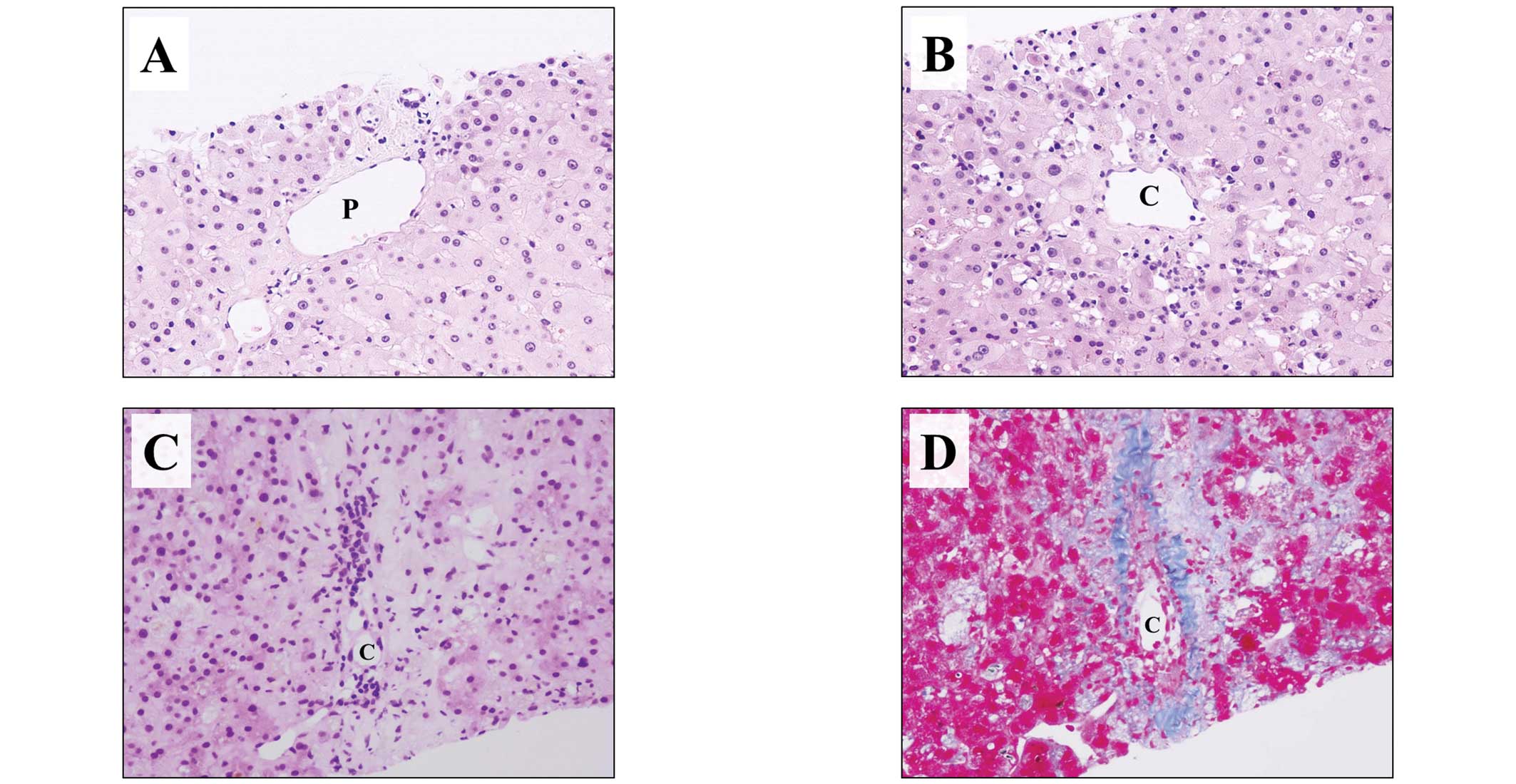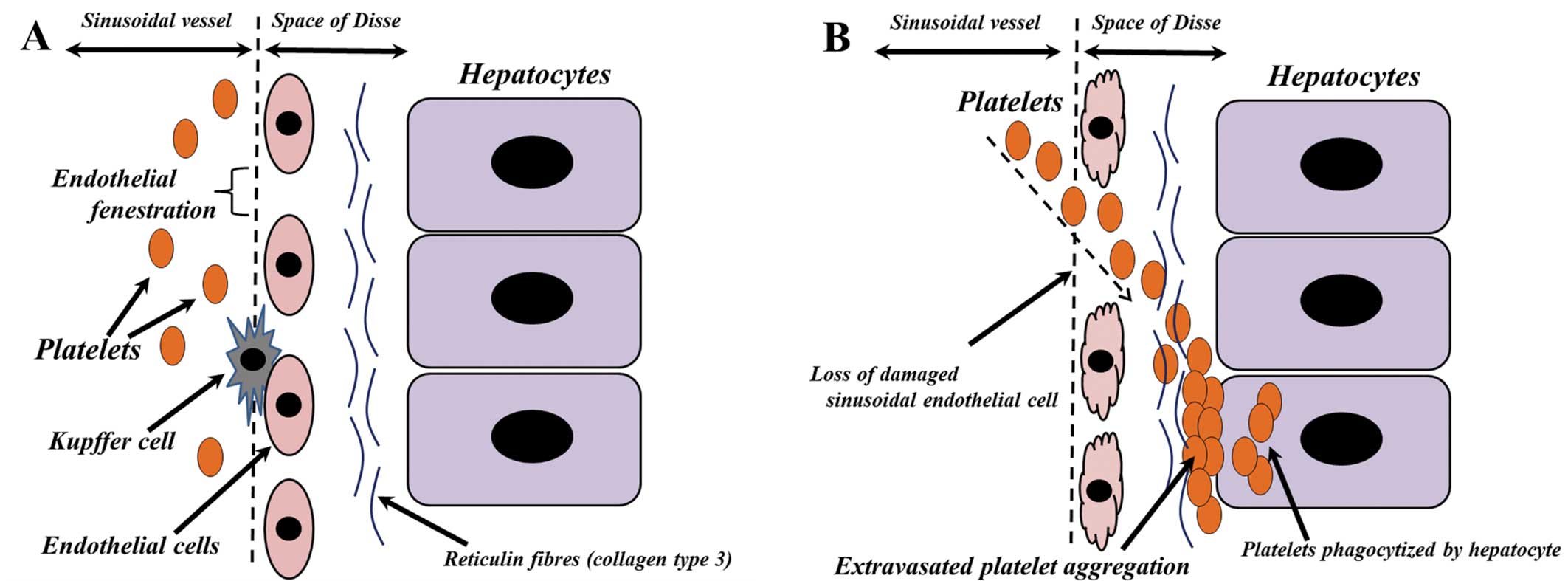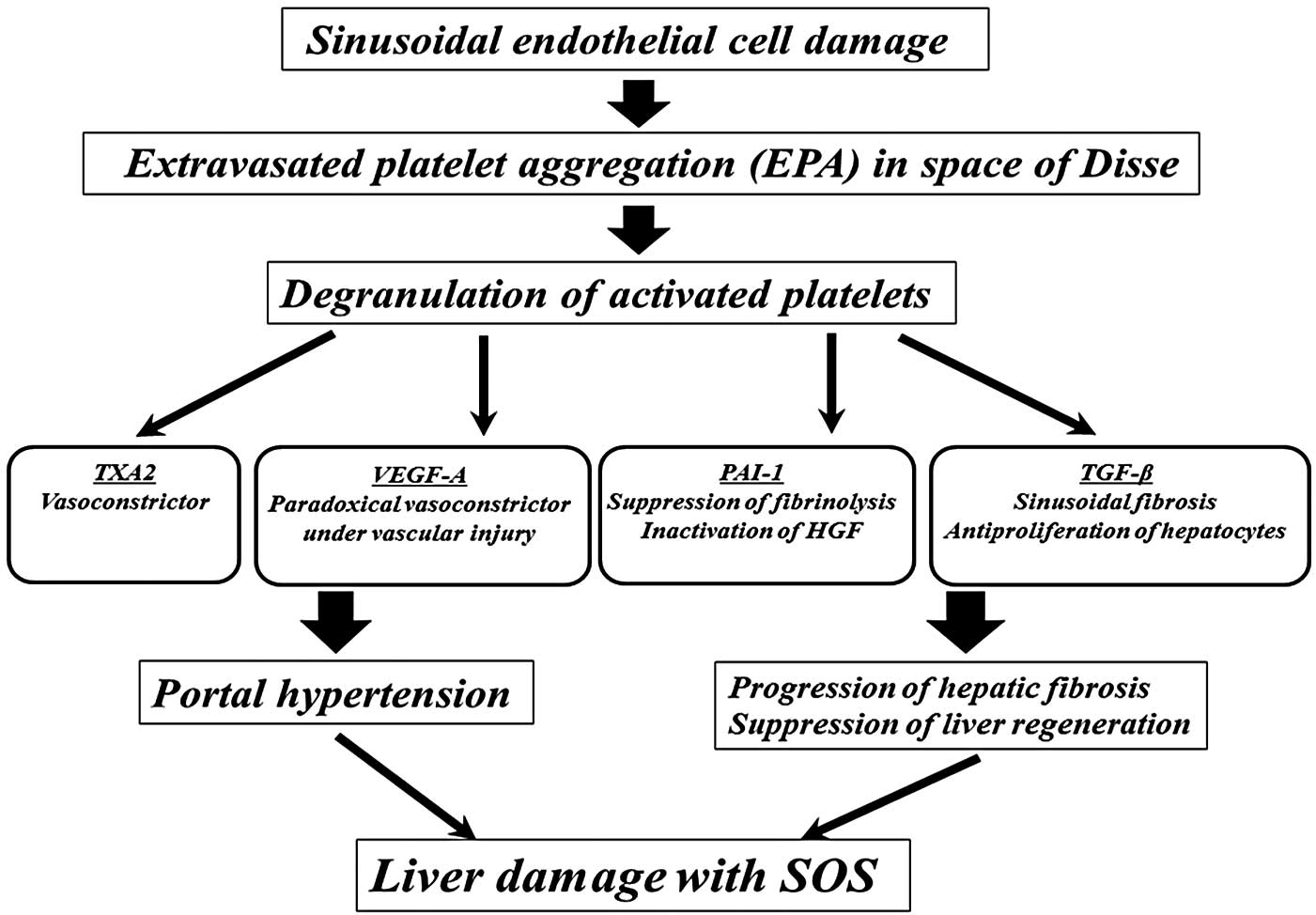|
1
|
Kitajima K, Vaillant JC, Charlotte F, et
al: Intractable ascites without mechanical vascular obstruction
after orthotopic liver transplantation: etiology and clinical
outcome of sinusoidal obstruction syndrome. Clin Transplant.
24:139–148. 2010. View Article : Google Scholar
|
|
2
|
Campos-Varela I, Castells L, Dopazo C, et
al: Transjugular intrahepatic portosystemic shunt for the treatment
of sinusoidal obstruction syndrome in a liver transplant recipient
and review of the literature. Liver Transpl. 18:201–205. 2012.
View Article : Google Scholar
|
|
3
|
Membreno FE, Ortiz J, Foster PF, Wright F,
et al: Liver transplantation for sinusoidal obstructive syndrome
(veno-occlusive disease): case report with review of the literature
and the UNOS database. Clin Transplant. 22:397–404. 2008.
View Article : Google Scholar : PubMed/NCBI
|
|
4
|
Sebagh M, Debette M, Samuel D, et al:
‘Silent’ presentation of veno-occlusive disease after liver
transplantation as part of the process of cellular rejection with
endothelial predilection. Hepatology. 30:1144–1150. 1999.
View Article : Google Scholar : PubMed/NCBI
|
|
5
|
Coppell JA, Brown SA and Perry DJ:
Veno-occlusive disease: cytokines, genetics, and haemostasis. Blood
Rev. 17:63–70. 2003. View Article : Google Scholar : PubMed/NCBI
|
|
6
|
Pihusch V, Pihusch M, Penovici M, et al:
Transforming growth factor beta-1 released from platelets
contributes to hypercoagulability in veno-occlusive disease
following hematopoetic stem cell transplantation. Thromb Res.
116:233–240. 2005. View Article : Google Scholar : PubMed/NCBI
|
|
7
|
Salat C, Holler E, Kolb HJ, et al:
Plasminogen activator inhibitor-1 confirms the diagnosis of hepatic
veno-occlusive disease in patients with hyperbilirubinemia after
bone marrow transplantation. Blood. 89:2184–2188. 1997.PubMed/NCBI
|
|
8
|
Oh H, Tahara T, Bouvier M, et al: Plasma
thrombopoietin levels in marrow transplant patients with
veno-occlusive disease of the liver. Bone Marrow Transplant.
22:675–679. 1998. View Article : Google Scholar : PubMed/NCBI
|
|
9
|
Wiesner RH, McDiarmid SV, Kamath PS, et
al: MELD and PELD: application of survival models to liver
allocation. Liver Transpl. 7:567–580. 2001. View Article : Google Scholar : PubMed/NCBI
|
|
10
|
Chen H, Wang X, Fan T, et al: A case of
veno-occlusive disease following liver transplantation. Exp Ther
Med. 7:141–144. 2014.
|
|
11
|
Wang SE, Shyr YM and Lee RC: Hepatic
veno-occlusive disease related to tacrolimus after pancreas
transplantation. J Chin Med Assoc. 76:358–360. 2013. View Article : Google Scholar : PubMed/NCBI
|
|
12
|
Shulman HM, Gown AM and Nugent DJ: Hepatic
veno-occlusive disease after bone marrow transplantation.
Immunohistochemical identification of the material within occluded
central venules. Am J Pathol. 127:549–558. 1987.PubMed/NCBI
|
|
13
|
Cogger VC, McNerney GP and Nyunt T:
Three-dimensional structured illumination microscopy of liver
sinusoidal endothelial cell fenestrations. J Struct Biol.
171:382–388. 2010. View Article : Google Scholar : PubMed/NCBI
|
|
14
|
Mak KM and Lieber CS: Alterations in
endothelial fenestrations in liver sinusoids of baboons fed
alcohol: a scanning electron microscopic study. Hepatology.
4:386–391. 1984. View Article : Google Scholar : PubMed/NCBI
|
|
15
|
Yamamoto M, Sumiyoshi H, Nakagami K and
Tahara E: Distribution of collagen types I, III, and V in fibrotic
and neoplastic human liver. Acta Pathol Jpn. 34:77–86.
1984.PubMed/NCBI
|
|
16
|
Jung SM, Takemura Y, Imamura Y, et al:
Collagen-type specificity of glycoprotein VI as a determinant of
platelet adhesion. Platelets. 19:32–42. 2008. View Article : Google Scholar : PubMed/NCBI
|
|
17
|
Brech A, Kjeken R, Synnes M, et al:
Endocytosed ricin and asialoorosomucoid follow different
intracellular pathways in hepatocytes. Biochim Biophys Acta.
1373:195–208. 1998. View Article : Google Scholar : PubMed/NCBI
|
|
18
|
Steirer LM, Park EI, Townsend RR, et al:
The asialoglycoprotein receptor regulates levels of plasma
glycoproteins terminating with sialic acid alpha2,6-galactose. J
Biol Chem. 284:3777–3783. 2009. View Article : Google Scholar :
|
|
19
|
Sørensen AL, Rumjantseva V, Nayeb-Hashemi
S, et al: Role of sialic acid for platelet life span: exposure of
beta-galactose results in the rapid clearance of platelets from the
circulation by asialoglycoprotein receptor-expressing liver
macrophages and hepatocytes. Blood. 114:1645–1654. 2009. View Article : Google Scholar : PubMed/NCBI
|
|
20
|
Golebiewska EM and Poole AW: Platelet
secretion: From haemostasis to wound healing and beyond. Blood Rev.
Oct 31–2014.(Epub ahead of print). View Article : Google Scholar : PubMed/NCBI
|
|
21
|
Mohammad SF, Anderson WH, Smith JB, et al:
Effects of heparin on platelet aggregation and release and
thromboxane A2 production. Am J Pathol. 104:132–141.
1981.PubMed/NCBI
|
|
22
|
Anitua E, Andia I, Ardanza B, et al:
Autologous platelets as a source of proteins for healing and tissue
regeneration. Thromb Haemost. 91:4–15. 2004.
|
|
23
|
Ruan Z, Shibamoto T, Shimo T, et al:
Effects of platelet-activating factor and thromboxane A2 on
isolated perfused guinea pig liver. Prostaglandins Other Lipid
Mediat. 73:73–85. 2004. View Article : Google Scholar : PubMed/NCBI
|
|
24
|
Parenti A, Brogelli L, Filippi S, et al:
Effect of hypoxia and endothelial loss on vascular smooth muscle
cell responsiveness to VEGF-A: role of flt-1/VEGF-receptor-1.
Cardiovasc Res. 55:201–212. 2002. View Article : Google Scholar : PubMed/NCBI
|
|
25
|
Ribero D, Wang H, Donadon M, et al:
Bevacizumab improves pathologic response and protects against
hepatic injury in patients treated with oxaliplatin-based
chemotherapy for colorectal liver metastases. Cancer.
110:2761–2767. 2007. View Article : Google Scholar : PubMed/NCBI
|
|
26
|
Mars WM, Zarnegar R and Michalopoulos GK:
Activation of hepatocyte growth factor by the plasminogen
activators uPA and tPA. Am J Pathol. 143:949–958. 1993.PubMed/NCBI
|
|
27
|
Watanabe K, Togo S, Takahashi T, et al:
PAI-1 plays an important role in liver failure after excessive
hepatectomy in the rat. J Surg Res. 143:13–19. 2007. View Article : Google Scholar : PubMed/NCBI
|
|
28
|
Ueda S, Yamanoi A, Hishikawa Y, et al:
Transforming growth factor-beta1 released from the spleen exerts a
growth inhibitory effect on liver regeneration in rats. Lab Invest.
83:1595–1603. 2003. View Article : Google Scholar : PubMed/NCBI
|
|
29
|
Watanabe T, Tajima H, Hironori H, et al:
Sodium valproate blocks the transforming growth factor (TGF)-β1
autocrine loop and attenuates the TGF-β1-induced collagen synthesis
in a human hepatic stellate cell line. Int J Mol Med. 28:919–925.
2011.PubMed/NCBI
|
|
30
|
Yamada N, Urahashi T, Ihara Y, et al:
Veno-occlusive disease/sinusoidal obstruction syndrome associated
with potential antibody-mediated rejection after pediatric living
donor liver transplantation: a case report. Transplant Proc.
44:810–813. 2012. View Article : Google Scholar : PubMed/NCBI
|
|
31
|
Zhang L, Wang Y and Huang H: Defibrotide
for the prevention of hepatic veno-occlusive disease after
hematopoietic stem cell transplantation: a systematic review. Clin
Transplant. 26:511–519. 2012. View Article : Google Scholar : PubMed/NCBI
|
|
32
|
Iba T, Kidokoro A, Fukunaga M, et al:
Comparison of the protective effects of type III phosphodiesterase
(PDE3) inhibitor (cilostazol) and acetylsalicylic acid on
intestinal microcirculation after ischemia reperfusion injury in
mice. Shock. 26:522–526. 2006. View Article : Google Scholar : PubMed/NCBI
|
|
33
|
Wang S, Yan C, Xu H, Zhao X and Han Y:
Suppression of encephalitogenic T-cell responses by cilostazol is
associated with upregulation of regulatory T cells. Neuroreport.
21:629–635. 2010. View Article : Google Scholar : PubMed/NCBI
|














